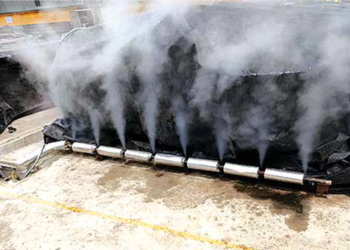
Even as the employes & workers of Railways SBG are busy constructing railway tracks, bridges, and overhead electrification systems, they have not lost their focus to minimize their environmental impact and contribute positively to Planet Earth.
Automated steam curing system at MAHSR T3
An innovative Automated Steam Curing System with digital temperature monitoring and automatic flow control has been introduced at the Mumbai– Ahmedabad High-Speed Rail (MAHSR) T3 Project, to enhance the production of 46,000+ track slabs using the Japanese Shinkansen technology. The team’s challenges were to maintain precise curing conditions to prevent slab defects and meet a demanding production cycle of 66 slabs per day.
By introducing Resistance Temperature Detectors (RTDs) with automatic steam control valves and a cloud-based monitoring system, they significantly reduced manual labour & improved process accuracy, and can remotely monitor via mobile applications.
The results are impressive: a substantial environmental impact translating to reduction in carbon emissions by savings of 335,800 litres of industrial fuel oil worth ₹1.81 crore, energy efficiency, and operational scalability.
Using ‘Industrial Soft Oil’ instead of ‘Light Diesel Oil’ at MAHSR T3
During the precast manufacturing process, slabs had to be steam cured, and the steam for such applications are typically generated by boilers using Light Diesel Oil (LDO). At MAHSR T3, the team decided to use ‘Industrial Sot Oil’ instead, which is a blend of edible oil residues, aromatic oil content, and recycled waste oils that can be reported as ‘Biodiesel’.
In FY 2024–25, approximately 158 KL of biodiesel was utilized, achieving a 90% reduction in emissions compared to using LDO.

Automatic steam control valve

Steam outflow operating with automatic valves

Track Slab Production Engineer Pavan Didel controlling the steam curing process remotely from his office
Conserving water through earthwork
The team’s Water Conservation Programme transforms construction activities into opportunities for community development. During earthwork, as soil is excavated for project needs, simultaneously ponds and water bodies are created, which serve as long-term irrigation resources for the local population. This initiative has been successfully implemented across multiple project sites, including WDFC CTP 3R and CTP 1 & 2 in Rajasthan, the Sambalpur–Barapali project in Odisha, and Bina–Ganjbasoda in Madhya Pradesh, reflecting our commitment to sustainable development and community legacy.
Key highlights of this initiative at the
Bina–Ganjbasoda Project:
- Blanketing & track bed formation requires large quantity of soil
- Option to source soil locally or from a distant location
- Land (borrow pits) taken on lease from local villagers for soil resource
- Borrow pits subsequently converted as water reservoirs and catchment areas during monsoons
- Knowhow and support given to local villagers & landowners to construct and use borrow pits as water reservoirs